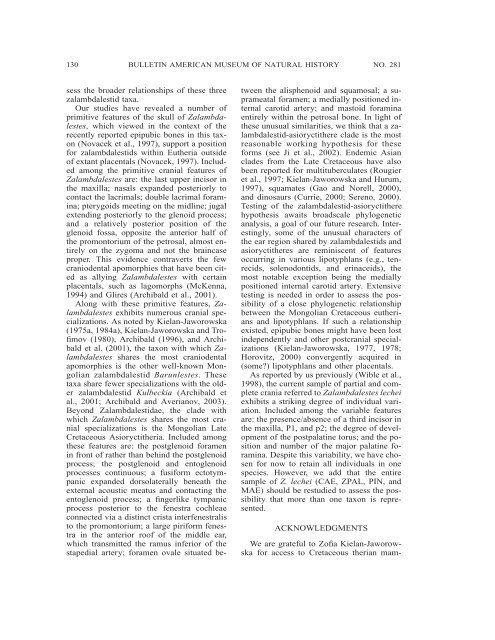zalambdalestes - American Museum of Natural History
zalambdalestes - American Museum of Natural History
zalambdalestes - American Museum of Natural History
You also want an ePaper? Increase the reach of your titles
YUMPU automatically turns print PDFs into web optimized ePapers that Google loves.
130 BULLETIN AMERICAN MUSEUM OF NATURAL HISTORY NO. 281<br />
sess the broader relationships <strong>of</strong> these three<br />
zalambdalestid taxa.<br />
Our studies have revealed a number <strong>of</strong><br />
primitive features <strong>of</strong> the skull <strong>of</strong> Zalambdalestes,<br />
which viewed in the context <strong>of</strong> the<br />
recently reported epipubic bones in this taxon<br />
(Novacek et al., 1997), support a position<br />
for zalambdalestids within Eutheria outside<br />
<strong>of</strong> extant placentals (Novacek, 1997). Included<br />
among the primitive cranial features <strong>of</strong><br />
Zalambdalestes are: the last upper incisor in<br />
the maxilla; nasals expanded posteriorly to<br />
contact the lacrimals; double lacrimal foramina;<br />
pterygoids meeting on the midline; jugal<br />
extending posteriorly to the glenoid process;<br />
and a relatively posterior position <strong>of</strong> the<br />
glenoid fossa, opposite the anterior half <strong>of</strong><br />
the promontorium <strong>of</strong> the petrosal, almost entirely<br />
on the zygoma and not the braincase<br />
proper. This evidence contraverts the few<br />
craniodental apomorphies that have been cited<br />
as allying Zalambdalestes with certain<br />
placentals, such as lagomorphs (McKenna,<br />
1994) and Glires (Archibald et al., 2001).<br />
Along with these primitive features, Zalambdalestes<br />
exhibits numerous cranial specializations.<br />
As noted by Kielan-Jaworowska<br />
(1975a, 1984a), Kielan-Jaworowska and Tr<strong>of</strong>imov<br />
(1980), Archibald (1996), and Archibald<br />
et al. (2001), the taxon with which Zalambdalestes<br />
shares the most craniodental<br />
apomorphies is the other well-known Mongolian<br />
zalambdalestid Barunlestes. These<br />
taxa share fewer specializations with the older<br />
zalambdalestid Kulbeckia (Archibald et<br />
al., 2001; Archibald and Averianov, 2003).<br />
Beyond Zalambdalestidae, the clade with<br />
which Zalambdalestes shares the most cranial<br />
specializations is the Mongolian Late<br />
Cretaceous Asioryctitheria. Included among<br />
these features are: the postglenoid foramen<br />
in front <strong>of</strong> rather than behind the postglenoid<br />
process; the postglenoid and entoglenoid<br />
processes continuous; a fusiform ectotympanic<br />
expanded dorsolaterally beneath the<br />
external acoustic meatus and contacting the<br />
entoglenoid process; a fingerlike tympanic<br />
process posterior to the fenestra cochleae<br />
connected via a distinct crista interfenestralis<br />
to the promontorium; a large piriform fenestra<br />
in the anterior ro<strong>of</strong> <strong>of</strong> the middle ear,<br />
which transmitted the ramus inferior <strong>of</strong> the<br />
stapedial artery; foramen ovale situated between<br />
the alisphenoid and squamosal; a suprameatal<br />
foramen; a medially positioned internal<br />
carotid artery; and mastoid foramina<br />
entirely within the petrosal bone. In light <strong>of</strong><br />
these unusual similarities, we think that a zalambdalestid-asioryctithere<br />
clade is the most<br />
reasonable working hypothesis for these<br />
forms (see Ji et al., 2002). Endemic Asian<br />
clades from the Late Cretaceous have also<br />
been reported for multituberculates (Rougier<br />
et al., 1997; Kielan-Jaworowska and Hurum,<br />
1997), squamates (Gao and Norell, 2000),<br />
and dinosaurs (Currie, 2000; Sereno, 2000).<br />
Testing <strong>of</strong> the zalambdalestid-asioryctithere<br />
hypothesis awaits broadscale phylogenetic<br />
analysis, a goal <strong>of</strong> our future research. Interestingly,<br />
some <strong>of</strong> the unusual characters <strong>of</strong><br />
the ear region shared by zalambdalestids and<br />
asioryctitheres are reminiscent <strong>of</strong> features<br />
occurring in various lipotyphlans (e.g., tenrecids,<br />
solenodontids, and erinaceids), the<br />
most notable exception being the medially<br />
positioned internal carotid artery. Extensive<br />
testing is needed in order to assess the possibility<br />
<strong>of</strong> a close phylogenetic relationship<br />
between the Mongolian Cretaceous eutherians<br />
and lipotyphlans. If such a relationship<br />
existed, epipubic bones might have been lost<br />
independently and other postcranial specializations<br />
(Kielan-Jaworowska, 1977, 1978;<br />
Horovitz, 2000) convergently acquired in<br />
(some?) lipotyphlans and other placentals.<br />
As reported by us previously (Wible et al.,<br />
1998), the current sample <strong>of</strong> partial and complete<br />
crania referred to Zalambdalestes lechei<br />
exhibits a striking degree <strong>of</strong> individual variation.<br />
Included among the variable features<br />
are: the presence/absence <strong>of</strong> a third incisor in<br />
the maxilla, P1, and p2; the degree <strong>of</strong> development<br />
<strong>of</strong> the postpalatine torus; and the position<br />
and number <strong>of</strong> the major palatine foramina.<br />
Despite this variability, we have chosen<br />
for now to retain all individuals in one<br />
species. However, we add that the entire<br />
sample <strong>of</strong> Z. lechei (CAE, ZPAL, PIN, and<br />
MAE) should be restudied to assess the possibility<br />
that more than one taxon is represented.<br />
ACKNOWLEDGMENTS<br />
We are grateful to Z<strong>of</strong>ia Kielan-Jaworowska<br />
for access to Cretaceous therian mam-
















